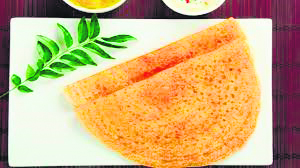
Dosa, a traditional South Indian dish, can indeed be a healthy food option when crafted with attention to nutritious ingredients and consumed in moderation. The foundation of dosa lies in its batter, typically made from a blend of fermented rice and urad dal (black gram) that imparts a unique texture and taste to this beloved dish. The fermentation process is a key factor contributing to the healthiness of dosa.
Fermented Batter for Enhanced Nutrient Absorption: Fermentation is a natural process that involves the breakdown of carbohydrates and proteins in the batter by microorganisms. This process not only imparts a tangy flavor to dosa but also increases the bioavailability of nutrients. The beneficial bacteria involved in fermentation predigest certain compounds, making them easier for the body to absorb. As a result, fermented dosa batter becomes a source of nutrients that may be more readily absorbed by the digestive system.
Incorporating Whole Grains for Nutritional Boost: To elevate the nutritional profile of dosa, one can consider incorporating whole grains into the batter. Whole grain rice or alternative grains like ragi (finger millet) or oats add fiber, vitamins, and minerals to the dosa. Whole grains are known for their complex carbohydrates, providing sustained energy and contributing to overall dietary fiber intake, which is essential for digestive health.
Opting for Minimal Oil or Healthier Cooking Oils: The method of cooking also plays a crucial role in determining the healthiness of dosa. Cooking dosa with minimal oil or using healthier cooking oils, such as olive oil or coconut oil, can be a mindful choice. These oils contain healthier fats, including monounsaturated fats in olive oil and medium-chain triglycerides (MCTs) in coconut oil, which are considered more heart-friendly compared to saturated fats.
Nutritious Accompaniments for a Balanced Meal: The overall healthiness of dosa extends beyond the batter itself to the accompaniments and side dishes. Serving dosa with nutritious accompaniments like sambar, a lentil-based vegetable stew rich in proteins and vitamins, adds depth to the meal. Coconut chutney, made with coconut, yogurt, and various spices, contributes healthy fats and additional flavors. Including a variety of vegetable fillings further enhances the nutritional content of the meal.
Portion Control for a Balanced Diet: As with any food, moderation is key when enjoying dosa. Being mindful of portion sizes helps maintain a balanced diet. While dosa can be a nutritious part of a meal, it’s essential to incorporate a diverse range of foods from different food groups to ensure that the body receives a comprehensive array of nutrients.
Conclusion: In conclusion, dosa can be a healthy and flavorful addition to a well-rounded diet when prepared thoughtfully.
By focusing on fermented batter, incorporating whole grains, using minimal oil or healthier cooking oils, choosing nutritious accompaniments, and practicing portion control, individuals can savor the deliciousness of dosa while promoting overall health. It’s advisable for individuals with specific dietary concerns or health conditions to consult with a nutritionist or healthcare professional for personalized advice tailored to their unique needs.